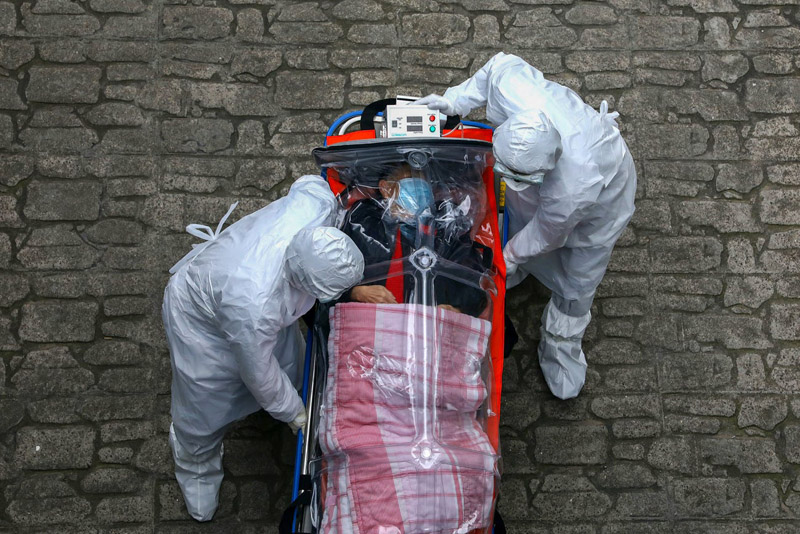
(TibetanReview.net, Apr16’20) – The Chinese leadership knew that the novel coronavirus situation was serious on Jan 13, when the first case of coronavirus outside of China was reported in Thailand, but President Xi Jinping failed to warn the public until a week later, on Jan 20, when more than 3,000 cases had been confirmed within the country, reported the AP Apr 15, citing internal Chinese government memos and documents. But according to foxnews.com Apr 16, the Chinese leadership’s cover-up operation began much earlier.
The foxnews.com report noted that on Dec 6, 2019, Lancet, a peer-reviewed medical journal, reported that a man linked to the Wuhan wildlife market experiences pneumonia-like symptoms. Five days later his wife, who had no direct connection to the market, also experienced similar symptoms, which would suggest a human-to-human spread.

Then on Dec 27, the scmp.com cited Zhang Jixian, a doctor from Hubei Provincial Hospital of Integrated Chinese and Western Medicine, as having told health authorities that the novel disease that was then affecting some 180 patients, was caused by a new coronavirus.
On Dec 31, the Citizen Lab at the University of Toronto discovered that Chinese authorities had begun censoring certain internet terms from social media, such as: Wuhan Unknown Pneumonia, SARS Variation, Wuhan Seafood Market, and other keywords that condemned the government’s handling of the outbreak.
Later on Jan 1, CNN featured a story about Dr Li Wenliang, who was one of eight doctors in Wuhan warning about the spread of the virus on social media in late Dec 2019. He not only ended up contracting Covid-19 but was labeled a “rumor-mongerer” by Wuhan police, after being detained for making false statements. He was also forced to write a self-criticism saying his warnings “had a negative impact.”
The severe reprimand of the eight doctors was reported in a broadcast on national television on Jan 2.
On Jan 3, China’s top health officials at the National Health Commission followed the Hubei Health Commission and issued a gag order directing that Wuhan pneumonia samples be moved to testing facilities, or destroyed. Besides, Caixin Global reported that the National Health Commission had also ordered institutions not to publish any scientific information related to the virus.
The WHO came into the picture on Jan 5, when it wrote: “Based on the preliminary information from the Chinese investigation team, no evidence of significant human-to-human transmission and no health care worker infections have been reported.”
Reuters Jan 14 cited the chief of the WHO’s emerging diseases unit as reporting, “it is possible that there is limited human-to-human transmission, potentially among families, but it is very clear right now that we have no sustained human-to-human transmission.”
The WHO also sent out a tweet claiming that Chinese authorities had conducted a preliminary investigation that found no evidence of human-to-human transmission of the coronavirus.
Less than two months later, the WHO was to declare the novel coronavirus a global pandemic.
Jan 14 was also the day on which the head of China’s National Health Commission, Ma Xiaowei, laid out a grim assessment of the situation in a confidential teleconference with provincial health officials. The teleconference was held to convey instructions on the coronavirus from President Xi, Premier Li Keqiang and Vice Premier Sun Chunlan. AP said the internal documents it had obtained did not specify what those instructions were.
Then on Jan 21, the day after Xi’s warning about the new viral disease, a WHO delegation concluded a two-day field visit to Wuhan and noted that “Data collected through detailed epidemiological investigation and through the deployment of the new test kit nationally suggests that human-to-human transmission is taking place in Wuhan.”
Finally on Jan 23, Chinese authorities locked down Wuhan. But that was after they had let some five million people leave the city without any medical screening in the weeks prior, as reported by the Wall Street Journal.
And in the six days after top Chinese officials secretly determined they likely were facing a pandemic from a new coronavirus, the city of Wuhan at the epicenter of the disease hosted a mass banquet for tens of thousands of people; millions began traveling through for Lunar New Year celebrations, noted the AP report.
On Mar 11, researchers from the University of Southampton, in the United Kingdom, reported that if Beijing had responded early to the outbreak, there would have been significantly fewer cases. They said if Beijing responded three weeks sooner, 95 percent of its cases could have been avoided.





